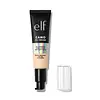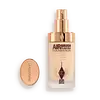What's inside
What's inside
 Key Ingredients
Key Ingredients

 Benefits
Benefits

 Concerns
Concerns

 Ingredients Side-by-side
Ingredients Side-by-side

Water
Skin ConditioningDimethicone
EmollientCyclopentasiloxane
EmollientButylene Glycol
HumectantPhenyl Trimethicone
Skin ConditioningCetyl PEG/PPG-10/1 Dimethicone
EmulsifyingButylene Glycol Dicaprylate/Dicaprate
EmollientButyloctyl Salicylate
Skin ConditioningPolyglyceryl-4 Isostearate
EmulsifyingMethyl Methacrylate Crosspolymer
Cyclohexasiloxane
EmollientAcrylates/Polytrimethylsiloxymethacrylate Copolymer
Skin ConditioningHexyl Laurate
EmollientMagnesium Sulfate
Phenoxyethanol
PreservativeTriethoxycaprylylsilane
Disteardimonium Hectorite
StabilisingHydrated Silica
AbrasiveAluminum Hydroxide
EmollientPropylene Carbonate
SolventDimethicone/Methicone Copolymer
Caprylyl Glycol
EmollientEthylhexylglycerin
Skin ConditioningDisodium EDTA
Tocopheryl Acetate
AntioxidantSodium Hyaluronate
HumectantNiacinamide
SmoothingPanthenol
Skin ConditioningAscorbyl Palmitate
AntioxidantSoluble Collagen
HumectantCanola Oil
EmollientGlycerin
HumectantDaucus Carota Sativa Seed Oil
EmollientCarbomer
Emulsion StabilisingDaucus Carota Sativa Root Extract
Skin ConditioningHelianthus Annuus Seed Oil
EmollientBeta-Carotene
Skin ConditioningPolysorbate 20
EmulsifyingPalmitoyl Tripeptide-1
Skin ConditioningPalmitoyl Tetrapeptide-7
Skin Conditioning1,2-Hexanediol
Skin ConditioningCI 77891
Cosmetic ColorantCI 77492
Cosmetic ColorantCI 77491
Cosmetic ColorantCI 77499
Cosmetic ColorantWater, Dimethicone, Cyclopentasiloxane, Butylene Glycol, Phenyl Trimethicone, Cetyl PEG/PPG-10/1 Dimethicone, Butylene Glycol Dicaprylate/Dicaprate, Butyloctyl Salicylate, Polyglyceryl-4 Isostearate, Methyl Methacrylate Crosspolymer, Cyclohexasiloxane, Acrylates/Polytrimethylsiloxymethacrylate Copolymer, Hexyl Laurate, Magnesium Sulfate, Phenoxyethanol, Triethoxycaprylylsilane, Disteardimonium Hectorite, Hydrated Silica, Aluminum Hydroxide, Propylene Carbonate, Dimethicone/Methicone Copolymer, Caprylyl Glycol, Ethylhexylglycerin, Disodium EDTA, Tocopheryl Acetate, Sodium Hyaluronate, Niacinamide, Panthenol, Ascorbyl Palmitate, Soluble Collagen, Canola Oil, Glycerin, Daucus Carota Sativa Seed Oil, Carbomer, Daucus Carota Sativa Root Extract, Helianthus Annuus Seed Oil, Beta-Carotene, Polysorbate 20, Palmitoyl Tripeptide-1, Palmitoyl Tetrapeptide-7, 1,2-Hexanediol, CI 77891, CI 77492, CI 77491, CI 77499
Water
Skin ConditioningCyclopentasiloxane
EmollientIsododecane
EmollientPEG-10 Dimethicone
Skin ConditioningPropanediol
SolventPolyglyceryl-4 Isostearate
EmulsifyingSilica
AbrasiveNylon-12
Phenoxyethanol
PreservativeDisteardimonium Hectorite
StabilisingPolysorbate 20
EmulsifyingDimethyl Isosorbide
SolventDimethicone Crosspolymer
Emulsion StabilisingTriethoxycaprylylsilane
Menthyl PCA
HumectantSodium Dehydroacetate
PreservativeArginine PCA
HumectantAluminum Hydroxide
EmollientTocopheryl Acetate
AntioxidantParfum
MaskingIsomalt
HumectantSodium Phytate
Phaeodactylum Tricornutum Extract
HumectantAcetyl Tetrapeptide-11
Skin ConditioningAcetyl Tetrapeptide-9
Skin ConditioningAlcohol
AntimicrobialPhytol
EmollientAlpha-Isomethyl Ionone
PerfumingBenzyl Salicylate
PerfumingCitronellol
PerfumingLimonene
PerfumingCI 77891
Cosmetic ColorantIron Oxides
Water, Cyclopentasiloxane, Isododecane, PEG-10 Dimethicone, Propanediol, Polyglyceryl-4 Isostearate, Silica, Nylon-12, Phenoxyethanol, Disteardimonium Hectorite, Polysorbate 20, Dimethyl Isosorbide, Dimethicone Crosspolymer, Triethoxycaprylylsilane, Menthyl PCA, Sodium Dehydroacetate, Arginine PCA, Aluminum Hydroxide, Tocopheryl Acetate, Parfum, Isomalt, Sodium Phytate, Phaeodactylum Tricornutum Extract, Acetyl Tetrapeptide-11, Acetyl Tetrapeptide-9, Alcohol, Phytol, Alpha-Isomethyl Ionone, Benzyl Salicylate, Citronellol, Limonene, CI 77891, Iron Oxides
Ingredients Explained
These ingredients are found in both products.
Ingredients higher up in an ingredient list are typically present in a larger amount.
Aluminum Hydroxide is a form of aluminum. It can be naturally found in nature as the mineral gibbsite. In cosmetics, Aluminum Hydroxide is used as a colorant, pH adjuster, and absorbent.
As a colorant, Aluminum Hydroxide may add opacity, or reduce the transparency. Aluminum hydroxide is contains both basic and acidic properties.
According to manufacturers, this ingredient is an emollient and humectant. This means it helps hydrate the skin.
In medicine, this ingredient is used to help relieve heartburn and help heal ulcers.
There is currently no credible scientific evidence linking aluminum hydroxide in cosmetics to increased cancer risk.
Major health organizations allow the use of aluminum hydroxide in personal care products and have not flagged it as a carcinogenic risk at typical usage levels.
Learn more about Aluminum HydroxideCi 77891 is a white pigment from Titanium dioxide. It is naturally found in minerals such as rutile and ilmenite.
It's main function is to add a white color to cosmetics. It can also be mixed with other colors to create different shades.
Ci 77891 is commonly found in sunscreens due to its ability to block UV rays.
Learn more about CI 77891Cyclopentasiloxane, or D5, is a silicone used to improve texture of products and trap moisture.
D5 is considered lightweight and volatile. Volatile means it evaporates quickly after application. Once evaporated, D5 leaves a thin barrier that helps keep skin hydrated.
It is also an emollient. Emollients help soften the skin and prevent water loss. Silicones create a silky texture in products. D5 helps other ingredients become more spreadable.
Studies show D5 is safe to use in skincare products. We recommend speaking with a skincare professional if you have concerns.
Learn more about CyclopentasiloxaneDisteardimonium Hectorite comes from the clay mineral named hectorite. It is used to add thickness to a product.
It can also help stabilize a product by helping to disperse other ingredients.
Hectorite is a rare, white clay mineral.
Learn more about Disteardimonium HectoritePhenoxyethanol is a preservative that has germicide, antimicrobial, and aromatic properties. Studies show that phenoxyethanol can prevent microbial growth. By itself, it has a scent that is similar to that of a rose.
It's often used in formulations along with Caprylyl Glycol to preserve the shelf life of products.
This ingredient is an emulsifer and stabilizer. It comes from isostearic acid and polyglycerin.
As an emulsifier, it helps blend oil and water to improve texture, spreadbility, and application.
Due to it being derived from isostearic acid, this ingredient may not be fungal acne safe.
Learn more about Polyglyceryl-4 IsostearatePolysorbate 20 is made by combining ethoxylation of sorbitan, ethylene oxide, and lauric acid. It is a mild cleansing agent, surfactant, and emulsifier.
As a surfactant, it helps collect dirt and oils for washing. Emulsifiers prevent oils and water from separating.
Polysorbate 20 also adds scent to a product. Since it is made using sorbitol, it has a sweet scent. Sorbitol can also be found in fruits such as apples and peaches.
The lauric acid used to create Polysorbate 20 is often derived from coconuts.
Polysorbate 20 may not be fungal acne safe.
Learn more about Polysorbate 20Tocopheryl Acetate is AKA Vitamin E. It is an antioxidant and protects your skin from free radicals. Free radicals damage the skin by breaking down collagen.
One study found using Tocopheryl Acetate with Vitamin C decreased the number of sunburned cells.
Tocopheryl Acetate is commonly found in both skincare and dietary supplements.
Learn more about Tocopheryl AcetateTriethoxycaprylylsilane is a silicone used to bind and stabilize ingredients.
As an emulsifier, it helps prevent ingredients from separating. This can help elongate the shelf life of products.
Triethoxycaprylylsilane is often used to coat mineral sunscreens ingredients to help give a better feel. It also helps reduce oxidative stress in sunscreens.
Learn more about TriethoxycaprylylsilaneWater. It's the most common cosmetic ingredient of all. You'll usually see it at the top of ingredient lists, meaning that it makes up the largest part of the product.
So why is it so popular? Water most often acts as a solvent - this means that it helps dissolve other ingredients into the formulation.
You'll also recognize water as that liquid we all need to stay alive. If you see this, drink a glass of water. Stay hydrated!
Learn more about Water